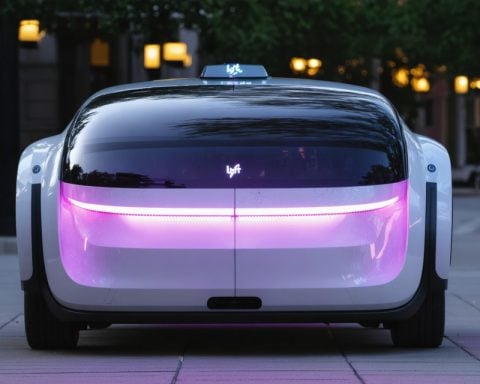- Tesla continues to lead in the electric vehicle (EV) and sustainable energy sectors with innovative solutions and strategies.
- Recent quarterly results show revenue growth to $25.7 billion, yet at a slower pace than previous years, highlighting challenges amidst fierce competition and thin profit margins.
- Price reductions in key markets like China and North America signal Tesla’s strategic response to increasing market competition.
- Robust free cash flow of $2 billion supports ongoing technological and manufacturing advancements.
- High stock valuation indicates investor confidence, although new entrants like Rivian, Lucid, and Li Auto pose significant threats.
- Innovations in Full Self-Driving technology and battery developments, alongside products like Megapack and Powerwall, reinforce Tesla’s sustainable energy goals.
- The challenge for Tesla is balancing expansion with sustainability to maintain investor and market interest in an evolving EV landscape.
Tesla, a titan of innovation in the electric vehicle (EV) and sustainable energy arena, continues to dazzle with its visionary strides. Navigating through a sea of startups and giants alike, it has steadfastly paved the way for a cleaner, smarter future of transportation. The gleam of its leadership, however, is met with the gritty reality of fierce competition and razor-thin margins.
The company’s latest quarterly results paint a picture of steadfast growth, yet with a tempered pace. Tesla boasted a commendable $25.7 billion in revenue, a modest rise that whispers of slowed momentum compared to its meteoric past. As research and development expenses loom and rivals circle, Tesla has sharpened its strategy by slashing prices in competitive markets like China and North America. Free cash flow, however, remains robust at $2 billion, fueling further leaps in technology and manufacturing clout.
Tesla’s stock valuation is a puzzle wrapped in an enigma. Investors’ faith manifests in sky-high price-to-earnings ratios. Yet, it teeters on the precipice, with little room for missteps as new challengers like Rivian, Lucid, and Li Auto gain traction. Each poses unique threats—Rivian with rugged utility, Lucid with luxury flair, and Li Auto’s Chinese charge, forcing Tesla to defend its stronghold.
Tesla’s allure partly rests in its disruptive Full Self-Driving technology and pioneering battery advances. Its Megapack and Powerwall further anchor its aspirations in the realm of sustainable energy, edging it toward becoming a holistic energy giant.
The takeaway? Tesla dazzles with promise and potential but must deftly balance expansion with sustainability, lest it risks the costly wrath of investor doubt. In the ever-evolving EV landscape, Tesla’s journey electrifies—the question remains whether it can continue to spark and sustain the burning interest of its investors and enthusiasts.
Is Tesla’s Momentum Stalling? Learn How They Plan to Electrify the Future!
Tesla’s Strategic Moves in the EV Landscape: A Deep Dive
Tesla’s leadership in the electric vehicle (EV) industry is indisputable, and the company’s influence extends beyond vehicles to energy solutions. But, how does Tesla plan to keep its edge with increasing competition, and what’s next for them in the fast-evolving market?
How-To Steps & Life Hacks
1. Maximize Your Tesla Experience with Software Updates: Tesla vehicles receive over-the-air (OTA) updates, similar to a smartphone, which improve features and performance. Ensure your vehicle is connected to Wi-Fi regularly to get the latest enhancements.
2. Optimize Charging: Use Tesla’s extensive Supercharger network for long trips, but rely on home charging for daily needs to save costs. Invest in a home charging setup for maximum convenience and efficiency.
3. Understand Battery Management: To prolong battery life, avoid excessive fast charging and minimize levels dropping too low (80%) regularly.
Real-World Use Cases
– Urban Commuters: Tesla models like the Model 3 provide eco-friendly solutions for daily commuting while reducing emissions.
– Family Travel: The spacious Model Y or Model X offers families comfort and advanced safety features for road trips.
– Renewable Integration: Tesla’s Powerwall and solar products allow homeowners to reduce dependence on the grid and make the most of solar energy.
Market Forecasts & Industry Trends
– Growth Predictions: According to reports by Bloomberg, the EV market is expected to grow exponentially, with projections suggesting sales could account for over 50% of all new car sales globally by 2040. Tesla is positioned well to benefit from this trend due to its brand recognition and early entry.
– Competitive Pressure: New entrants like Rivian, Lucid, and Chinese automakers are rapidly closing the gap. Price competitiveness and model diversity are key areas of focus for all players.
Reviews & Comparisons
– Model 3 vs. Lucid Air: While the Lucid Air offers greater luxury and range, the Tesla Model 3 is more affordable and benefits from Tesla’s expansive charging infrastructure.
– Rivian vs. Tesla: Rivian’s focus on rugged, utility-driven vehicles contrasts with Tesla’s sleek, tech-forward approach. Each brand appeals to different consumer bases.
Controversies & Limitations
– Autonomous Driving Concerns: Tesla’s Full Self-Driving (FSD) technology has faced scrutiny over safety concerns and regulatory approval. Continuous improvement and transparent communication are vital to maintaining customer trust.
– Pricing Tactics: Recent price drops in markets like China and North America could squeeze margins further, although they are necessary to stay competitive.
Features, Specs & Pricing
– Model S Plaid Specs:
– 0-60 mph: 1.99 seconds
– Range: 396 miles
– Price: Starting at approximately $94,990
– Model 3 Performance:
– 0-60 mph: 3.1 seconds
– Range: 315 miles
– Price: Starting at approximately $53,990
Security & Sustainability
– Cybersecurity: Tesla’s OTA updates improve system security. Regular system updates and Bluetooth/Wi-Fi security can reduce hacking risks.
– Sustainability: Tesla’s commitment to renewable energy and battery recycling programs demonstrates environmental responsibility.
Insights & Predictions
– Expanding Infrastructure: New Supercharger stations and renewable energy projects are expected to support global expansion.
– Battery Technology Advancements: Continued R&D into battery density and longevity will be pivotal in leading the EV charge.
Tutorials & Compatibility
– Navigate Tesla’s Infotainment System: Users can explore features like integrated music streaming services, navigation, and climate control through the intuitive interface.
– Compatibility with Smart Homes: Tesla’s Powerwall integrates with smart home systems to enhance energy efficiency and sustainability.
Pros & Cons Overview
Pros:
– Comprehensive charging infrastructure.
– Leading-edge technology and software updates.
– Strong brand presence and market influence.
Cons:
– High initial vehicle costs.
– Competition cutting into market share.
– Ongoing regulatory challenges with autonomous driving systems.
Actionable Recommendations
1. For EV Buyers: Consider your specific needs; Tesla offers models for various lifestyles, from compact sedans to spacious SUVs.
2. For Investors: Stay informed about Tesla’s quarterly earnings and strategic shifts due to market competition.
3. For Enthusiasts: Explore Tesla’s role in sustainable energy beyond automobiles—Powerwall and Solar Roof products lead in home energy management.
For more information about Tesla, visit the official Twitter site. Keep a close eye on this dynamic industry as it continues to evolve with new technologies and entrant competitors.















